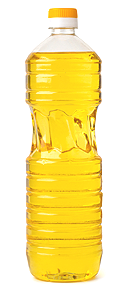Oils
What Are "Oils"?
Oils are fats that are liquid at room temperature, like the vegetable oils used in cooking. Oils come from many different plants and from fish. Oils are NOT a food group, but they provide essential nutrients. Therefore, oils are included in USDA food patterns.

Some commonly eaten oils include:
- canola oil
- corn oil
- cottonseed oil
- olive oil
- safflower oil
- soybean oil
- sunflower oil
Some oils are used mainly as flavorings, such as walnut oil and sesame oil. A number of foods are naturally high in oils, like:
- nuts
- olives
- some fish
- avocados
Foods that are mainly oil include mayonnaise, certain salad dressings, and soft (tub or squeeze) margarine with no trans fats. Check the Nutrition Facts label to find margarines with 0 grams of trans fat. Amounts of trans fat are required to be listed on labels.
Most oils are high in monounsaturated or polyunsaturated fats, and low in saturated fats. Oils from plant sources (vegetable and nut oils) do not contain any cholesterol. In fact, no plant foods contain cholesterol.
A few plant oils, however, including coconut oil, palm oil, and palm kernel oil, are high in saturated fats and for nutritional purposes should be considered to be solid fats.
Solid fats are fats that are solid at room temperature, like butter and shortening. Solid fats come from many animal foods and can be made from vegetable oils through a process called hydrogenation. Some common fats are:
- butter
- milk fat
- beef fat (tallow, suet)
- chicken fat
- pork fat (lard)
- stick margarine
- shortening
- partially hydrogenated oil